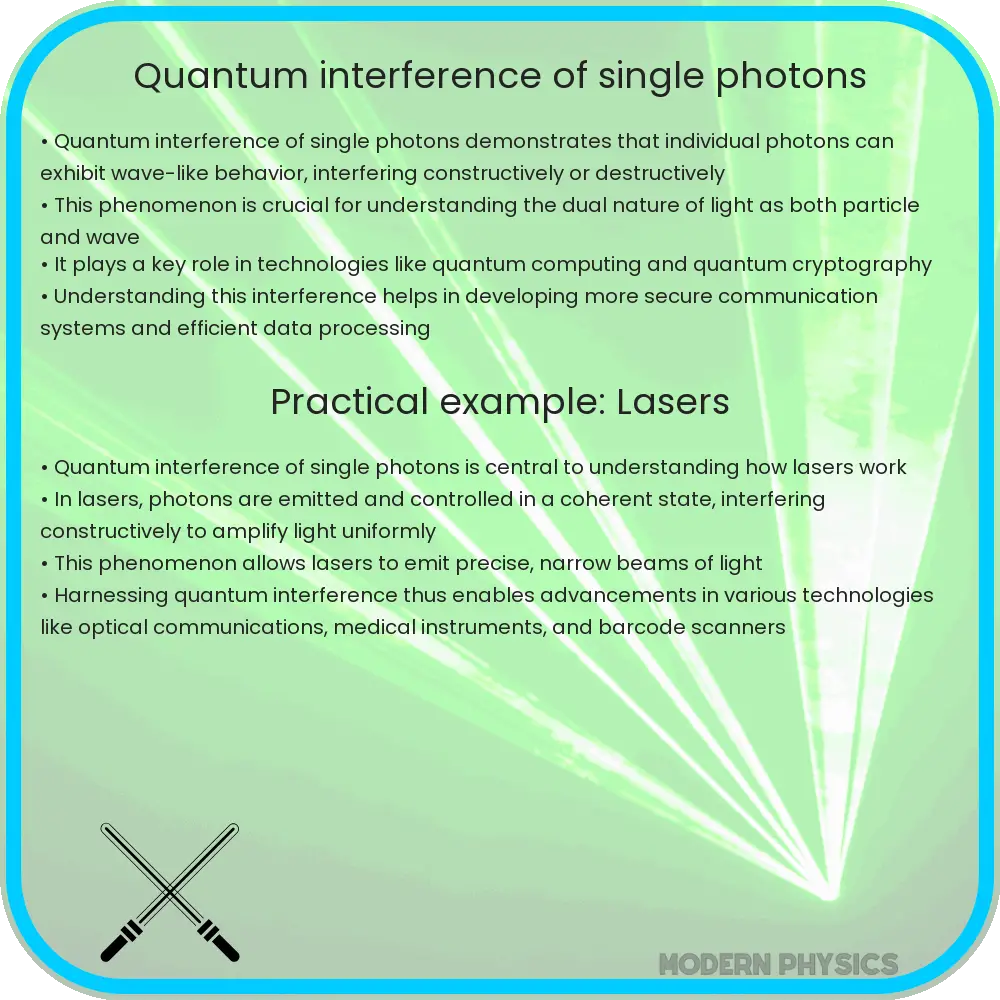Explore the fascinating world of quantum interference of single photons, its role in coherence, detection techniques, and groundbreaking applications.

Understanding Quantum Interference of Single Photons
Quantum interference of single photons represents a cornerstone phenomenon in the realm of quantum physics, providing deep insights into the nature of light and matter at the quantum level. This principle is pivotal for various advanced applications in quantum computing, secure communication, and precision measurement. At its core, quantum interference illustrates how individual photons can exhibit wave-like properties, interfering with themselves or each other under certain conditions, leading to observable patterns that defy classical physics expectations.
Coherence in Quantum Interference
Coherence is a fundamental aspect of quantum interference, referring to the phase relationship between waves at different points in space and time. For single photons, coherence is essential for interference to occur, as it dictates how the wave functions of photons overlap and interact. Coherent sources of light, such as lasers, are often used in experiments to observe interference patterns effectively. The coherence length and time are critical parameters that determine the visibility and scale of the interference pattern.
Detection of Quantum Interference
The detection of quantum interference requires sophisticated equipment capable of observing single photons. Photodetectors, such as avalanche photodiodes (APDs) and superconducting nanowire single-photon detectors (SNSPDs), are commonly employed for this purpose. These detectors are designed to be sensitive enough to respond to the arrival of a single photon, allowing scientists to measure interference patterns with high precision. The ability to detect and analyze quantum interference at the single-photon level is crucial for exploring the fundamental principles of quantum mechanics and for the development of quantum technologies.
Applications of Quantum Interference
Quantum interference of single photons has a wide range of applications in cutting-edge technologies. In quantum computing, interference is used to perform operations on qubits, the basic units of quantum information, enabling the execution of algorithms that could solve problems intractable for classical computers. Quantum cryptography utilizes the principles of quantum interference for secure communication, ensuring that any attempt to eavesdrop on the transmission can be detected. Additionally, quantum interference is instrumental in quantum metrology, improving the precision of measurements beyond the limits imposed by classical physics.
Exploring Further: Quantum Interference in Research and Technology
The exploration of quantum interference extends beyond theoretical understanding to practical experiments and technological innovations. Recent advancements in quantum optics and nanotechnology have enabled researchers to manipulate photons and their paths with unprecedented precision. For instance, experiments involving the double-slit setup with single photons have vividly demonstrated the wave-particle duality of light, reinforcing the quantum theory that particles can exhibit both particle-like and wave-like behavior depending on the observational context.
Moreover, the development of quantum networks relies heavily on the principles of quantum interference. These networks aim to connect quantum computers, sensors, and other devices over long distances, using the interference of single photons to transmit quantum information securely and efficiently. This endeavor could revolutionize data transmission and security, marking a significant leap forward in the development of a quantum internet.
Challenges and Future Directions
Despite the promising applications of quantum interference, several challenges remain. One of the main hurdles is the decoherence of quantum states, where interaction with the environment causes a loss of coherence, disrupting the interference pattern. Researchers are actively exploring ways to protect quantum states from decoherence, including the use of quantum error correction and the development of materials and structures that can isolate quantum systems from their surroundings.
Furthermore, scaling up the technologies that utilize quantum interference, such as quantum computers and networks, requires innovative solutions to maintain coherence and control over an increasing number of qubits and photonic components. Advances in materials science, photonics, and quantum information theory are crucial for overcoming these obstacles.
Conclusion
Quantum interference of single photons illuminates the profound principles of quantum mechanics, showcasing the dual nature of light and offering a foundation for a host of revolutionary technologies. From the basic scientific curiosity that drives experiments in quantum coherence and detection to the ambitious applications in computing, communication, and measurement, the study of quantum interference is at the forefront of quantum research and technology. As we continue to unravel the mysteries of quantum mechanics and harness the capabilities of quantum interference, we pave the way for advancements that could transform our technological landscape and expand our understanding of the universe. The journey from theoretical physics to practical applications underscores the power of human curiosity and ingenuity, promising a future where quantum technologies reshape our world.
